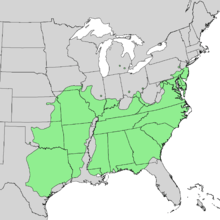Quercus marilandica
| Blackjack oak | |
|---|---|
 | |
| Dormant blackjack in the Cross Timbers of Lincoln County, Oklahoma | |
| Scientific classification | |
| Kingdom: | Plantae |
| (unranked): | Angiosperms |
| (unranked): | Eudicots |
| (unranked): | Rosids |
| Order: | Fagales |
| Family: | Fagaceae |
| Genus: | Quercus |
| Section: | Lobatae |
| Species: | Q. marilandica |
| Binomial name | |
| Quercus marilandica Muenchh. | |
 | |
Quercus marilandica (blackjack oak) is a small oak, one of the red oak group Quercus sect. Lobatae, but fairly isolated from the others. It is native to the southern and central United States, with populations following the eastern seaboard north to Long Island.[1]

It is a small deciduous tree growing to 15 m tall, with bark cracked into rectangular black plates with narrow orange fissures. The leaves are 7–20 cm long and broad, and typically flare from a tapered base to a broad three-lobed bell shape with only shallow indentations. They are dark green and glossy above, pubescent underneath, and often remain attached to the twigs through the winter after turning colors from red to brown in the fall. The acorn is small, 12–20 mm long and 10–18 mm broad; like other red oaks, it takes 18 months to mature.
Habitat and distribution
The blackjack oak grows in poor, thin, dry, rocky or sandy soils where few other woody plants can thrive, usually on low ground, from sea level up to approximately 2800 feet (900 m) in altitude. It does not have the beautiful form of many oaks, but is nonetheless a valuable tree for growing in problem sites. It is sometimes an understory tree in pine stands on sandy knolls in the southeastern USA. Along the coastal plain of New Jersey the probability of finding this species is increased in relatively sunny, open areas such as those near coastal salt marshes. It often occurs near scarlet and post oaks as well as pitch pine; understory companions include winged sumac, bracken, sweetfern, and bayberry.
A variety, Quercus marilandica Münchhausen var. ashei Sudworth (D. M. Hunt 1989), grows in the western portions of its range—northern Texas, Oklahoma, and into southern Kansas. In this area, blackjack, along with post oak, forms a semi-savanna area composed of forested strips intermixed with prairie grass glades along the eastern edge of the southern Great Plains. This semi-savanna is known as the Cross Timbers. Scrub forms of Q.marilandica dominate on many chert glades along with Q.stellata in Arkansas' Ozark plateau.[2]
Blackjacks in the Cross Timbers can grow from 50 to 60 feet (15 to 18 m) high with a trunk diameter of 16 inches (41 cm), but seldom reach more than 40 feet (12 m). The leaves are from 4 to 10 inches (10 to 25 cm) in length and about the same width. Blackjack acorns provide food for both whitetail deer and wild turkey. Blackjacks may, however, cause tannic acid poisoning in cattle.
Uses
The wood is very dense and produces a hot flame when burned, which functions as an excellent source of heat for barbecues and wood-burning stoves. However, the wood is not desirable for wood fireplaces because the heat causes popping, thereby increasing the risk of house fires.
Traditionally blackjack wood is used as both a fuel and smoke wood for barbecue in Oklahoma.
Bibliography
- Quercus marilandica (L.) Muenchh. var. ashei Sudworth - USDA. (accessed March 4, 2007)
- Stephan L.Hatch and Jennifer Pluhar (eds.). Texas Range Plants. College Station: Texas A&M University Press, 1999. ISBN 0-89096-538-2
- C.Michael Hogan. 2012. Oak. Encyclopedia of Earth. Eds. A.Dawson and C.J.Cleveland. Encyclopedia of Earth. National Council for Science and the Environment. Washington DC
References
- ↑ ""Quercus marilandica Range Map"" (PDF). United States Geological Survey. Retrieved 2008-03-05.
- ↑ C.Michael Hogan. 2012
External links
| Wikimedia Commons has media related to Quercus marilandica. |